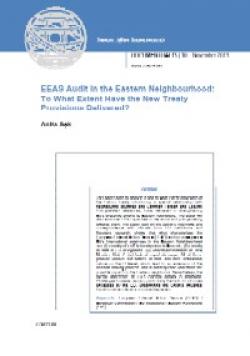EEAS Audit in the Eastern Neighbourhood: To What Extent Have the New Treaty Provisions Delivered?
This paper aims to analyse if and to what extent provisions of the Lisbon Treaty introducing a special relationship with neighbouring countries and Common Foreign and Security Policy-related references, have delivered in strengthening EU's presence among its Eastern neighbours. The paper will also examine EU's capacities in decision- and policy-making towards them. The study, built on the author's interviews and correspondence with officials from EU institutions and literature research, shows that what characterizes the European External Action Service (EEAS) and in consequence EU's international actorness in the Eastern Neighbourhood are: (i) scarcity of staff in headquarter in Brussels, (ii) scarcity of staff in EU delegations, (iii) underrepresentation of "new Member States", (iv) lack of esprit du corps. All of these produce various "turf battles" of intra- and inter- institutional nature on the EU-level, which lead to an extension of the decision-making process, and in consequence undermine the possible impact on the Eastern neighbours. Nevertheless, the overall coherence of EU's external activity is improving. Challenges however remain, particularly the lack of outcomes envisaged by the EU, undermining the Union's influential transformative role as a norms entrepreneur.
Versione rivista di un paper presentato al seminario Lisboan su "The European Neighbourhood Policy and the Lisbon Treaty: What has changed?", Roma, 22 marzo 2013.
-
Dati bibliografici
Roma, Istituto Affari Internazionali, 2013, 17 p. -
In:
-
Numero
1310
Introduction
1. EU and beyond
1.1. This is not philanthropy. It is 21st century European foreign policy
1.2. EEAS and EC structure on EaP
2. Struggling with limited resources
2.1. Scarcity of stuff in HQ
2.2. Scarcity of staff in delegations
2.3. Underrepresentation of "new Member States"
2.4. Lack of esprit du corps
2.5. Turf battles - bellum omnium contra omnes
3. EEAS-EaP policy-input
3.1. EEAS interest in the EaP
4. EEAS-EaP policy-output
4.1. EEAS and the "frozen conflicts"
Conclusions
References




